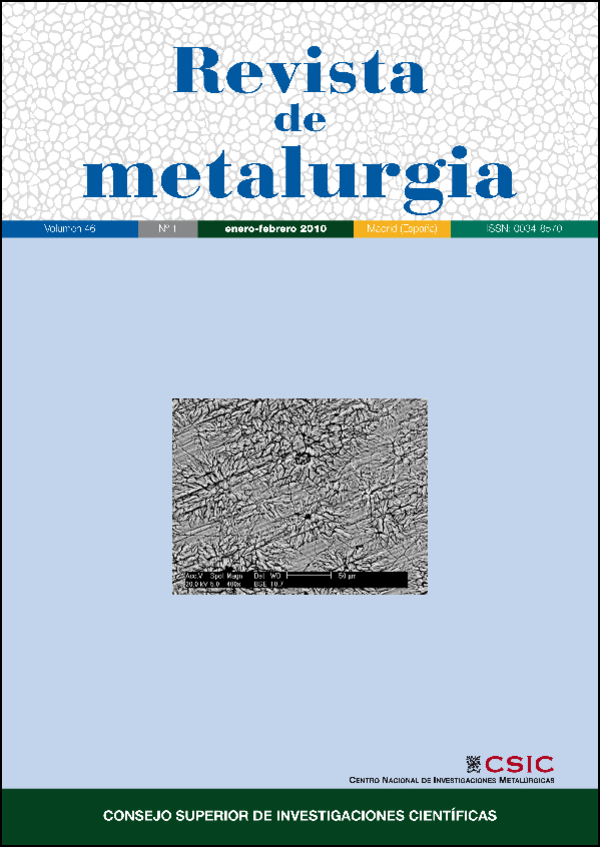Effect of aluminum content on austenite-ferrite transformation temperature in low carbon (Si-Al) hot rolled GNO electrical steels
DOI:
https://doi.org/10.3989/revmetalm.0938Keywords:
GNO steel, In-situ X-ray diffraction, Austenite-ferrite transformation, Electrical steel, Thin ferrite filmAbstract
The aim of the present study is to investigate the synergistic effect of silicon and aluminum content on the austeniteferrite transformation temperatures on cooling (Ar3, Ar1) in non-oriented (GNO) Al-Si-low carbon electrical steel strips. Two specimens with different Al contents: A=0.22 wt% and B=0.61 wt%Al, were analyzed by “in-situ” high temperature X-ray diffraction experiments. The samples were austenitized at 1050 °C for 5 minutes and sequentially cooling in a stepwise manner by steps of 10 °C inside an environmental chamber installed in a Philips X’Pert multi-purpose diffractometer. X-ray diffraction patterns were recorded every 10 °C during cooling from 1000 to 720 °C. The austenite to ferrite transformation temperatures on cooling, Ar3 and Ar1, were estimated from changes in the intensities of the (110)-α and (111)-γ peaks as a function of temperature. The results of the experiments show that the transformation temperatures increase with increasing aluminum content from 0.22 to 0.61 wt%. In addition, the two-phase field (austenite + ferrite in the system Fe-C decreases with increasing silicon and aluminum contents for these GNO steels. X-Ray diffraction results were supported by microstructural observations of quenched samples of steel B which were subjected to similar heat treatment conditions than those applied in the X-ray diffractometer experiments. Thin ferrite films (~ 4-10 μm) were observed in the microstructure of specimens of steel B quenched from temperatures close to the experimental Ar3.
Downloads
References
[1] E.O. García-Sánchez, E.A. Treviño-Luna, A. Salinas-Rodríguez and L.A. Leduc-Lezama. Rev. Metal. Madrid 43 (2006) 266-271.
[2] Silicon-Steel Electrical Sheets, pp. 1157-1162. Carbon Steels, Ninth Edition, pp.1117-1128.
[3] Den Hartog, Huibert W. (Noordwijkerhout, Nl) Van Haastrecht, Gijsbertus C. (Heemskerk, Nl). United States Patent 5262039.
[4] European Copper Institute (Eci), Fraunhofer-ISI, KU Leuven and University of Coimbra, Energy Efficient Motor Driven Systems, 2004.
[5] B. Mintz, S.Yue and J.J. Jonas. Int. Mater. Rev. 36 (1991) 187.
[6] J.Y. Fu, I. García, S. Pytel and A.J. de Ardo. Proc. Microstructure and Properties of HSLA Steels, 27. 1988. Warrendale, PA, U.S.A., Metallurgical Society of AIME.
[7] B.Mintz, S. Yue and J.J. Jonas, Int.Mater. Rev. 36 (1991) 187-217.
[8] J. Lewis, J. J. Jonas and B. Mintz, ISIJ Int. 38 (1998) 300-308. doi:10.2355/isijinternational.38.300
[9] A. Cowley, R. Abushosha and B.Mintz,Mater. Sci. Technol. 14 (1998), 1145-1153.
[10] B.Mintz, R. Abushosha andM. Shaker,Mater. Sci. Technol. 9 (1993) 907-914.
[11] B. Mintz, Importance of Ar3 temperature in controlling ductility and width of hot ductility trough in steels, and its relationship to transverse cracking. Department of Mechanical Engineering and Aeronautics, City University, London, vol. 12, nº 2, 1996, pp. 132-138 (19 ref.).
[12] J.H. Oh, S-H. Cho and J.J. Jonas, ISIJ Int. 41 (2001) 484-491. doi:10.2355/isijinternational.41.484
[13] B.Mintz, A. Tuling and A. Delgado,Mater. Sci. Technol. 19 (2003) 1721-1726. doi:10.1179/026708303225009418
[14] R.C Reed and H.K.D.H Bhadeshia,Mater. Sci. Technol. 8 (1992) 421-435.
Downloads
Published
How to Cite
Issue
Section
License
Copyright (c) 2010 Consejo Superior de Investigaciones Científicas (CSIC)

This work is licensed under a Creative Commons Attribution 4.0 International License.
© CSIC. Manuscripts published in both the printed and online versions of this Journal are the property of Consejo Superior de Investigaciones Científicas, and quoting this source is a requirement for any partial or full reproduction.
All contents of this electronic edition, except where otherwise noted, are distributed under a “Creative Commons Attribution 4.0 International” (CC BY 4.0) License. You may read the basic information and the legal text of the license. The indication of the CC BY 4.0 License must be expressly stated in this way when necessary.
Self-archiving in repositories, personal webpages or similar, of any version other than the published by the Editor, is not allowed.
















